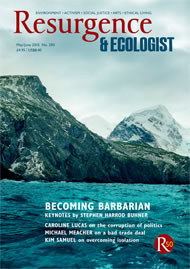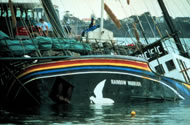There is a strong spiritual element to the story of Greenpeace, with both Native Americans and Quakers having an influence on its beginnings. This element is reflected in the type of the people who have served on Greenpeace ships: they are dedicated to the idea of a clean environment and of saving creatures such as the whale, and they are powerful opponents of nuclear power.
The environment group’s flagship derives its name from the Warriors of the Rainbow – the Cree legend about a group of spiritual people who will bring an end to wars and to the destruction of the planet. And the style of protest these Greenpeace ‘warriors’ adopted sprang from the Quaker example of bearing witness against nuclear tests. They sailed into the exclusion zone and put themselves in harm’s way to prevent the atmospheric tests.
This book celebrates the ship itself, or rather the three successive flagships bearing the name, and the crews who have sailed the seven seas and placed themselves in danger of injury and arrest for an ideal.
Having been a crew member of this and other Greenpeace ships, I have sailed with many of the people described. Their dedication and qualities of seamanship were exceptional and this book is a fine tribute to them – yet it is not the whole story.
As in any organisation, things do not always go to plan, especially when you are up against intelligent and sometimes nasty opponents – like the French military.
This book glosses over some of the mistakes caused by miscalculation and emphasises the successes and the campaigns won. Also, with so many dedicated and strong personalities, differences arise between crews and the onshore policy people. Mostly this is creative tension, and it is largely unrecorded here.
In that sense the book is a bit like an official Greenpeace history, rather than the ‘warts and all’ biography of an organisation very sensitive about its image.
The first Rainbow Warrior was a converted trawler, fitted with sails, on which I sailed before it was blown up by the French secret service in Auckland harbour in 1985, killing a photographer. Up to that point Greenpeace fitted the David and Goliath legend, but the worldwide sympathy and donations to the environmental cause that this act of state terrorism engendered meant the organisation grew enormously almost overnight, and it has kept growing ever since.
This book does not deal with the stresses that sudden growth caused, or the increasing sophistication and expense of the ships Greenpeace has used since, and whether this is morally justified. Nor does it discuss the business decisions: which campaigns brought in money and whether some should be dropped because they did not.
But, to be fair, the author comes into the story long after the first Rainbow Warrior had been sunk and the second ship of that name had taken up the same campaigns. She arrives when the legend has already been created, and she clearly fits into the mould of the idealists who went before her and are still following on. It is essentially a story of the good bits, and there have been many of those.
This is a lavishly illustrated book with many maps, graphs and photographs in its pages. They record the campaigns and the many exotic people involved. This is not surprising, of course, because having photographers and journalists on board to generate publicity is central to getting the Greenpeace message out, and it has been done very skilfully.
In the end this is a tribute to an organisation that has changed the world for the better, and the people who have sailed on the three incarnations of the Rainbow Warrior have rightly been lionised in this story.
Perhaps the best parts of the book are the factual backgrounds detailing the campaigns and why Greenpeace took them on. These are explained simply and forcefully and get you onside because most of their arguments for the environment are unanswerable. Reading the book reinforces my view that the world would be a poorer place without Greenpeace.
Paul Brown is Co-editor of the Climate News Network and is a former Environment Correspondent for The Guardian who sailed with Greenpeace on whaling campaigns and anti-nuclear demonstrations and to the Antarctic.







